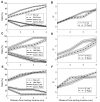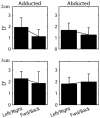Perception of Arm Position in Three-Dimensional Space
- PMID: 30186128
- PMCID: PMC6110942
- DOI: 10.3389/fnhum.2018.00331
Perception of Arm Position in Three-Dimensional Space
Abstract
Proprioception refers to the senses of body position, movement, force and effort. Previous studies have demonstrated workspace and direction-dependent differences in arm proprioceptive sensitivity within the horizontal plane. In addition, studies of reaching in the vertical plane have shown that proprioception plays a key role in anticipating arm configuration dependent effects of gravity. This suggests that proprioceptive sensitivity could vary with the direction of arm displacement relative to the gravitational vector, as well as with arm configuration. To test these hypotheses, and to characterize proprioception more generally, we assessed the direction-dependence and arm postural-dependence of proprioceptive sensitivity in 3D space using a novel robotic paradigm. A subject's right arm was coupled to a 7-df robot through a trough that stabilized the wrist and forearm, allowing for changes in configuration largely at the elbow and shoulder. Sensitivity was evaluated using a "same-different" task, where the subject's hand was moved 1-4 cm away from an initial "test" position to a 2nd "judgment" position. The proportion of trials where subjects responded "different" when the positions were different ("hit rate"), and where they responded "different" when the positions were the same, ("false alarm rate"), were used to calculate d', a measure of sensitivity derived from signal detection theory (SDT). Initially, a single initial arm posture was used and displacements were performed in six directions: upward, downward, forward, backward, leftward and rightward of the test position. In a follow-up experiment, data were obtained for four directions and two initial arm postures. As expected, sensitivity (d') increased monotonically with distance for all six directions. Sensitivity also varied between directions, particularly at position differences of 2 and 3 cm. Overall, sensitivity reached near maximal values in this task at 2 cm for the leftward/rightward directions, 3 cm for upward/forward and 4 cm for the downward/backward directions. In addition, when data were grouped together for opposing directions, sensitivity showed a dependence upon arm posture. These data suggest arm proprioceptive sensitivity is both anisotropic in 3D space and configuration-dependent, which has important implications for sensorimotor control of the arm and human-robot interactions.
Keywords: position sense; proprioception; psychophysics; rehabilitation; robotics.
Figures






Similar articles
-
Mapping proprioception across a 2D horizontal workspace.PLoS One. 2010 Jul 29;5(7):e11851. doi: 10.1371/journal.pone.0011851. PLoS One. 2010. PMID: 20686612 Free PMC article. Clinical Trial.
-
Robot-Aided Upper-limb Proprioceptive Training in Three-Dimensional Space.IEEE Int Conf Rehabil Robot. 2019 Jun;2019:121-126. doi: 10.1109/ICORR.2019.8779529. IEEE Int Conf Rehabil Robot. 2019. PMID: 31374617
-
Arm muscle activation for static forces in three-dimensional space.J Neurophysiol. 1990 Dec;64(6):1818-37. doi: 10.1152/jn.1990.64.6.1818. J Neurophysiol. 1990. PMID: 2074466
-
Assessing kinesthetic proprioceptive function of the upper limb: a novel dynamic movement reproduction task using a robotic arm.PeerJ. 2021 May 3;9:e11301. doi: 10.7717/peerj.11301. eCollection 2021. PeerJ. 2021. PMID: 33987004 Free PMC article.
-
Measuring position sense.Exp Physiol. 2024 Nov 22. doi: 10.1113/EP092190. Online ahead of print. Exp Physiol. 2024. PMID: 39576257 Review.
Cited by
-
Posture dependent factors influence movement variability when reaching to nearby virtual objects.Front Neurosci. 2022 Oct 25;16:971382. doi: 10.3389/fnins.2022.971382. eCollection 2022. Front Neurosci. 2022. PMID: 36389217 Free PMC article.
-
Robotic Assessment of Wrist Proprioception During Kinaesthetic Perturbations: A Neuroergonomic Approach.Front Neurorobot. 2021 Mar 1;15:640551. doi: 10.3389/fnbot.2021.640551. eCollection 2021. Front Neurorobot. 2021. PMID: 33732131 Free PMC article.
-
Closed-loop control of a prosthetic finger via evoked proprioceptive information.J Neural Eng. 2021 Dec 2;18(6):10.1088/1741-2552/ac3c9e. doi: 10.1088/1741-2552/ac3c9e. J Neural Eng. 2021. PMID: 34814128 Free PMC article.
References
LinkOut - more resources
Full Text Sources
Other Literature Sources
Research Materials
Miscellaneous

